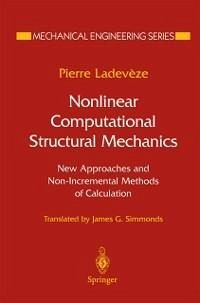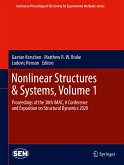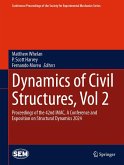Pierre LadevezeNew Approaches and Non-Incremental Methods of Calculation
Nonlinear Computational Structural Mechanics (eBook, PDF)
New Approaches and Non-Incremental Methods of Calculation
Übersetzer: Simmonds, J. G.
40,95 €
40,95 €
inkl. MwSt.
Sofort per Download lieferbar

20 °P sammeln
40,95 €
Als Download kaufen

40,95 €
inkl. MwSt.
Sofort per Download lieferbar

20 °P sammeln
Jetzt verschenken
Alle Infos zum eBook verschenken
40,95 €
inkl. MwSt.
Sofort per Download lieferbar
Alle Infos zum eBook verschenken

20 °P sammeln
Pierre LadevezeNew Approaches and Non-Incremental Methods of Calculation
Nonlinear Computational Structural Mechanics (eBook, PDF)
New Approaches and Non-Incremental Methods of Calculation
Übersetzer: Simmonds, J. G.
- Format: PDF
- Merkliste
- Auf die Merkliste
- Bewerten Bewerten
- Teilen
- Produkt teilen
- Produkterinnerung
- Produkterinnerung

Bitte loggen Sie sich zunächst in Ihr Kundenkonto ein oder registrieren Sie sich bei
bücher.de, um das eBook-Abo tolino select nutzen zu können.
Hier können Sie sich einloggen
Hier können Sie sich einloggen
Sie sind bereits eingeloggt. Klicken Sie auf 2. tolino select Abo, um fortzufahren.

Bitte loggen Sie sich zunächst in Ihr Kundenkonto ein oder registrieren Sie sich bei bücher.de, um das eBook-Abo tolino select nutzen zu können.
This book treats computational modeling of structures in which strong nonlinearities are present. The goal is to simulate the numerically the behavior of a structure under various imposed excitations, loads, and displacements in order to optimize the structure and to minimize the damage subject to various constraints.
- Geräte: PC
- ohne Kopierschutz
- eBook Hilfe
- Größe: 24.05MB
Andere Kunden interessierten sich auch für
![An Introduction to the History of Structural Mechanics (eBook, PDF) An Introduction to the History of Structural Mechanics (eBook, PDF)]() Edoardo BenvenutoAn Introduction to the History of Structural Mechanics (eBook, PDF)96,95 €
Edoardo BenvenutoAn Introduction to the History of Structural Mechanics (eBook, PDF)96,95 €![Nonlinear Structures & Systems, Volume 1 (eBook, PDF) Nonlinear Structures & Systems, Volume 1 (eBook, PDF)]() Nonlinear Structures & Systems, Volume 1 (eBook, PDF)160,95 €
Nonlinear Structures & Systems, Volume 1 (eBook, PDF)160,95 €![Nonlinear Structures & Systems, Vol. 1 (eBook, PDF) Nonlinear Structures & Systems, Vol. 1 (eBook, PDF)]() Nonlinear Structures & Systems, Vol. 1 (eBook, PDF)160,95 €
Nonlinear Structures & Systems, Vol. 1 (eBook, PDF)160,95 €![Special Topics in Structural Dynamics & Experimental Techniques, Vol. 5 (eBook, PDF) Special Topics in Structural Dynamics & Experimental Techniques, Vol. 5 (eBook, PDF)]() Special Topics in Structural Dynamics & Experimental Techniques, Vol. 5 (eBook, PDF)160,95 €
Special Topics in Structural Dynamics & Experimental Techniques, Vol. 5 (eBook, PDF)160,95 €![Masonry Construction (eBook, PDF) Masonry Construction (eBook, PDF)]() Masonry Construction (eBook, PDF)72,95 €
Masonry Construction (eBook, PDF)72,95 €![Mechanics of Solids and Fluids (eBook, PDF) Mechanics of Solids and Fluids (eBook, PDF)]() Franz ZieglerMechanics of Solids and Fluids (eBook, PDF)40,95 €
Franz ZieglerMechanics of Solids and Fluids (eBook, PDF)40,95 €![Dynamics of Civil Structures, Vol. 2 (eBook, PDF) Dynamics of Civil Structures, Vol. 2 (eBook, PDF)]() Dynamics of Civil Structures, Vol. 2 (eBook, PDF)160,95 €
Dynamics of Civil Structures, Vol. 2 (eBook, PDF)160,95 €-
-
-
This book treats computational modeling of structures in which strong nonlinearities are present. The goal is to simulate the numerically the behavior of a structure under various imposed excitations, loads, and displacements in order to optimize the structure and to minimize the damage subject to various constraints.
Dieser Download kann aus rechtlichen Gründen nur mit Rechnungsadresse in A, B, BG, CY, CZ, D, DK, EW, E, FIN, F, GR, HR, H, IRL, I, LT, L, LR, M, NL, PL, P, R, S, SLO, SK ausgeliefert werden.
Produktdetails
- Produktdetails
- Verlag: Springer US
- Seitenzahl: 222
- Erscheinungstermin: 6. Dezember 2012
- Englisch
- ISBN-13: 9781461214328
- Artikelnr.: 44179719
- Verlag: Springer US
- Seitenzahl: 222
- Erscheinungstermin: 6. Dezember 2012
- Englisch
- ISBN-13: 9781461214328
- Artikelnr.: 44179719
- Herstellerkennzeichnung Die Herstellerinformationen sind derzeit nicht verfügbar.
1 The Reference Problem for Small Disturbances.- 1.1. Notation.- 1.2. The reference problem.- 1.3. Sufficient conditions assuring uniqueness.- 1.4. Analogy with the basic problem of fluid mechanics.- 2 Material Models.- 2.1. Formulation with internal variables.- 2.2. Examples of material models.- 2.3. Formulation of the constitutive relation.- 2.4. Normal formulation of a constitutive model.- 2.5. Error as measured by the constitutive relation (error in CR).- 3 Solution Methods for Nonlinear Evolution Problems.- 3.1. The principle of incremental methods.- 3.2. Differential equation formulation of the reference problem.- 3.3. A general presentation of some classical methods for solving nonlinear problems.- 3.4. Other approaches to nonlinear evolution problems.- 4 Principles of the Method of Large Time Increments.- 4.1. Mechanics framework for the method of large time increments.- 4.2. Algorithms for two search directions.- 4.3. The local step.- 4.4. The global linear step.- 4.5. Convergence.- 4.6. A posteriori error estimates.- 4.7. Remarks.- 5 A Preliminary Example: A Beam in Traction.- 5.1. Quasi-static analysis for a viscoplastic material.- 5.2. Static analysis for a hyperelastic material.- 6 A "Mechanics Approximation" and Numerical Implementation.- 6.1. Discretization in time and space.- 6.2. Numerical treatment of the local step.- 6.3. Treatment of the linear global step in statics.- 6.4. Decomposition and approximation of the "radial loading" type for a function defined on ? × [0T].- 6.5. Applications and analysis of performance.- 7 Modeling and Calculation for Structures under Cyclic Loads.- 7.3. Treatment of the linear global step.- 7.4. A one-dimensional example.- 7.5. Example: viscoplastic disk with a loading of 1,000 cycles.- 8 Formulation and"Parallel" Strategies in Mechanics.- 8.1. Remarks on the degree of parallelism in the equations of reference.- 8.2. Partioning of the body into sub-structures and interfaces.- 8.3. Treatment of a static assemblage of elastic structures.- 8.4. Convergence for a static assemblage of elastic structures.- 8.5. Dynamic and static treatment of an assemblage of structures with nonlinear behavior.- 9 Modeling and Computation for Large Deformations.- 9.1. Material quantities and modeling of their behavior.- 9.2. Pure material formulation of large deformations-bases.- 9.3. Kinematic and other properties.- 9.4. Purely material formulation of the equilibrium of the body-properties and approximations.- 9.5. Two different representations of the modeling and computation of large deformations.- 9.6. Approaches to large time increments.- 9.7. Remarks and an example.
1 The Reference Problem for Small Disturbances.- 1.1. Notation.- 1.2. The reference problem.- 1.3. Sufficient conditions assuring uniqueness.- 1.4. Analogy with the basic problem of fluid mechanics.- 2 Material Models.- 2.1. Formulation with internal variables.- 2.2. Examples of material models.- 2.3. Formulation of the constitutive relation.- 2.4. Normal formulation of a constitutive model.- 2.5. Error as measured by the constitutive relation (error in CR).- 3 Solution Methods for Nonlinear Evolution Problems.- 3.1. The principle of incremental methods.- 3.2. Differential equation formulation of the reference problem.- 3.3. A general presentation of some classical methods for solving nonlinear problems.- 3.4. Other approaches to nonlinear evolution problems.- 4 Principles of the Method of Large Time Increments.- 4.1. Mechanics framework for the method of large time increments.- 4.2. Algorithms for two search directions.- 4.3. The local step.- 4.4. The global linear step.- 4.5. Convergence.- 4.6. A posteriori error estimates.- 4.7. Remarks.- 5 A Preliminary Example: A Beam in Traction.- 5.1. Quasi-static analysis for a viscoplastic material.- 5.2. Static analysis for a hyperelastic material.- 6 A "Mechanics Approximation" and Numerical Implementation.- 6.1. Discretization in time and space.- 6.2. Numerical treatment of the local step.- 6.3. Treatment of the linear global step in statics.- 6.4. Decomposition and approximation of the "radial loading" type for a function defined on ? × [0T].- 6.5. Applications and analysis of performance.- 7 Modeling and Calculation for Structures under Cyclic Loads.- 7.3. Treatment of the linear global step.- 7.4. A one-dimensional example.- 7.5. Example: viscoplastic disk with a loading of 1,000 cycles.- 8 Formulation and"Parallel" Strategies in Mechanics.- 8.1. Remarks on the degree of parallelism in the equations of reference.- 8.2. Partioning of the body into sub-structures and interfaces.- 8.3. Treatment of a static assemblage of elastic structures.- 8.4. Convergence for a static assemblage of elastic structures.- 8.5. Dynamic and static treatment of an assemblage of structures with nonlinear behavior.- 9 Modeling and Computation for Large Deformations.- 9.1. Material quantities and modeling of their behavior.- 9.2. Pure material formulation of large deformations-bases.- 9.3. Kinematic and other properties.- 9.4. Purely material formulation of the equilibrium of the body-properties and approximations.- 9.5. Two different representations of the modeling and computation of large deformations.- 9.6. Approaches to large time increments.- 9.7. Remarks and an example.







